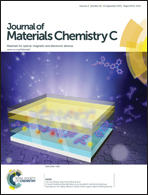Strong blue emissive nanofibers constructed from benzothizole modified tert-butyl carbazole derivative for the detection of volatile acid vapors†
Abstract
Two new benzothizole modified carbazole derivatives (CBT and TCBT) were synthesized. It was found that TCBT with a tert-butyl moiety could gel cyclohexane, cyclopentanol and octane/cyclohexane (v/v = 2/1) under ultrasound stimulus, but CBT without a tert-butyl group failed to form an organogel in the selected solvents, revealing that tert-butyl played an important role in gel formation. X-ray diffraction patterns of xerogels indicated that TCBT molecules self-assembled into a lamellar structure in the gel state. In particular, xerogel-based films of TCBT emitted strong blue light and could be used as fluorescent sensory materials to detect acid vapors of TFA, HCl, HNO3, formic acid and acetic acid with high performance on account of the good adsorption and diffusion of analytes in 3D networks consisting lots of nanofibers as well as the efficient exciton migration in nanofibers. It suggested that the organogelation of π-gelators was a facile way to generate efficient chemosensors.


 Please wait while we load your content...
Please wait while we load your content...